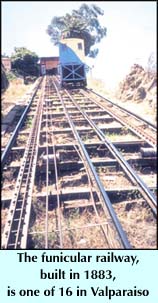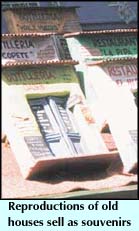
Quaint and cranky in bustling modernity
Valparaiso though congested, is one of South America's intriguing ports
There are 16 funicular railways in Valparaiso,
Chile's vast, accommodating port. They crawl up the side of hills stuck
in the middle of the town like something a kid has constructed from Meccano.
They were actually built by British engineers between 1883 and 1916. One
day I want to ride them all.
 They
are known as ascensors and are cable-powered railways with ascending and
descending cars counterbalanced on rails that creep almost to the vertical.
The Ascensor Artilleria on which I rode gives a panoramic vista of the
port and the Pacific Ocean. They
are known as ascensors and are cable-powered railways with ascending and
descending cars counterbalanced on rails that creep almost to the vertical.
The Ascensor Artilleria on which I rode gives a panoramic vista of the
port and the Pacific Ocean.
Its two cars trundle up and down all day and seem to be controlled by
an old woman in a cardigan who sits at the top selling tickets. The cars
themselves are like mobile hen coops, with windows blocked off by boards
to prevent people gazing out and getting frightened. The ascensor's survival
is due to development bypassing Valparaiso for neighbouring Vina del Mar
along the coast. There, a soulless stretch of condominiums blots the landscape.
Valparaiso was discovered in 1536 and boomed through ships that rounded
Cape Horn putting in there to provision. Chile's independence from Spain
added expansion as the port attracted many European immigrants. It is a
congested city but its ascensors, steep footpaths, zigzag roads and rambling
buildings make it one of South America's most intriguing ports.
Valparaiso represents downtown in an upmarket country. The country itself
is affected by being cut off from its neighbours, Argentina and Bolivia,
by the Andes, and from Peru by its long northern desert. Its eastern boundary
is 2,500 miles of Pacific coast. To the south is Antarctica.
The double-speak prose of an official tourist publication says: "During
the military regime human-rights were infringed and civil rights were restricted.
On the other hand, this regime (Pinochet's) was known for reducing the
slide of the state in the economy, privatising areas...... and introducing
market-oriented reforms."
The result is a country with the largest middle class (estimated at
60 percent of its population) in Latin America. The literacy rate is 95
percent; there is low infant mortality, an average life expectancy of 74
years and declining poverty levels.
The capital, Santiago, is 75 miles inland from Valparaiso, located in
the middle of wine growing country against the awe-inspiring backdrop of
the Andes. Its urban sprawl of distinct developed communities is linked
by the sullen waters of the Mapacho river.
It has succumbed to the thrusting, free-market dynamism that can change
an urban area into mazes of industrial parks, freeways, glittering office
high-rises, and suburban quaintness. It has the self-satisfied image of
an insular city that is doing quite well for itself, thank you very much.
You sense this in the restaurants, bars and cafes, which are so sophisticated,
that wear less than your best and you will feel out of place. Shopping
malls sport the latest fashions and the people seem so law-abiding.
In search of somewhere exotic to eat, I was advised to head for the
Mercado Central. This huge cast-iron structure was prefabricated in England
and shipped to Chile over a century ago. While it still has token vegetable
and fish stalls, it has been transformed by the genius of a simple fishmonger
into a gastronomic emporium.
Don Augusto used to offer his regular customers a glass of wine when
they bought seafood and fish from his market stall 20 years ago. As some
customers asked him to cook their purchases so they could eat at his stall,
he expanded it to a small restaurant.
Business was so good he opened another, and then another. Now he owns
most of the restaurants in the former market and is a millionaire. The
market opens only for lunch, which is long and leisurely, and eaten to
accompaniment by jolly, strolling musicians.
Good food deserves good wine, and the wines of Chile are among the best
in the world. There are vineyards to visit within 30 minutes of Santiago's
prosperous sprawl.
The estate of Cousino-Macul in the Maipo River Valley at the foot of
the Andes was first planted with vines in 1546.
Now it can produce 4,000 cases of wine a day and has facilities for
ageing over 2.5 million bottles of wine.
Guided tours let visitors see the process from the arrival of the grapes
to be crushed and pressed to obtain the must, the fermentation, ageing,
bottling and, a great treat, tasting.
 Two
hundred thousand cases a year of Cabernet Sauvignon and Merlot in red,
and Chardonnay and Sauvignon in white, are exported to 30 countries, including
Sri Lanka. Two
hundred thousand cases a year of Cabernet Sauvignon and Merlot in red,
and Chardonnay and Sauvignon in white, are exported to 30 countries, including
Sri Lanka.
Instead of wine as a souvenir, I bought an old house. There were dozens
of them on sale at a market stall.
They were miniature reproductions of the facades of old properties which
are being demolished in the modernisation of Chile's cities. I only hope
those unique and cranky ascensors won't be destroyed too.
|







